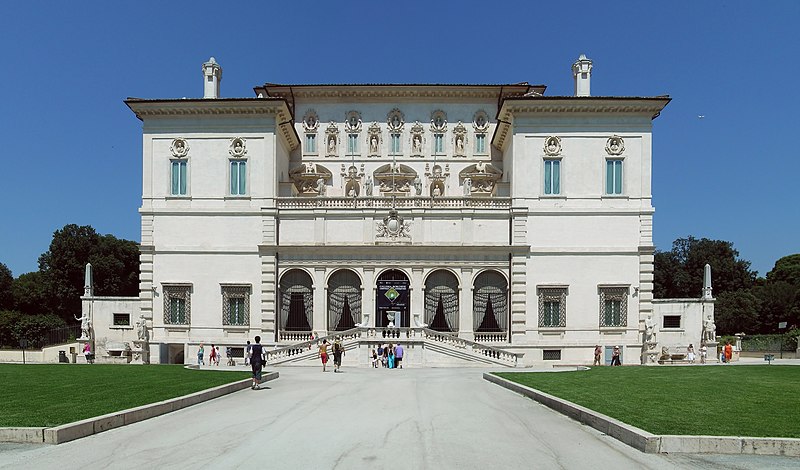
CHEAP TRAVEL EUROPE
GALLERIA BORGHESE
From Wikipedia, the free encyclopedia
The Borghese Gallery (Italian: Galleria Borghese) is an art gallery in Rome, Italy, housed in the former Villa Borghese Pinciana, a building that was from the first integral with its gardens, nowadays considered quite separately by tourists as the Villa Borghese gardens. The Galleria Borghese houses a substantial part of the Borghese collection of paintings, sculpture and antiquities, begun by Cardinal Scipione Borghese, the nephew of Pope Paul V (reign 1605–1621). The Villa was built by the architect Flaminio Ponzio, developing sketches by Scipione Borghese himself, who used it as a villa suburbana, a party villa at the edge of Rome.
Scipione Borghese was an early patron of Bernini and an avid collector of works by Caravaggio, who is well represented in the collection by his Boy with a Basket of Fruit, St. Jerome, Sick Bacchus and others. Other paintings of note include Titian's Sacred and Profane Love, Raphael's Entombment of Christ and works by Peter Paul Rubens and Federico Barocci.
History
The Casina Borghese lies on the outskirts of seventeenth-century Rome. By 1644, John Evelyn described it as "an Elysium of delight" with "Fountains of sundry inventions, Groves and small Rivulets of Water". Evelyn also described the Vivarium that housed ostriches, peacocks, swans and cranes "and divers strange Beasts". Prince Marcantonio IV Borghese (1730–1800), who began the recasting of the park's formal garden architecture into an English landscape garden, also set out about 1775, under the guidance of the architect Antonio Asprucci, to replace the now-outdated tapestry and leather hangings and renovate the Casina, restaging the Borghese sculptures and antiquities in a thematic new ordering that celebrated the Borghese position in Rome. The rehabilitation of the much-visited villa as a genuinely public museum in the late eighteenth century was the subject of an exhibition at the Getty Research Institute, Los Angeles, in 2000,[1] spurred by the Getty's acquisition of fifty-four drawings related to the project.
In 1808, Prince Camillo Borghese, Napoleon's brother-in-law,[2] was forced to sell the Borghese Roman sculptures and antiquities to the Emperor. The result is that the Borghese Gladiator, renowned since the 1620s as the most admired single sculpture in Villa Borghese, must now be appreciated in the Musée du Louvre. The "Borghese Hermaphrodite" is also now in the Louvre.

Collections
- See also Borghese collection.
The Galleria Borghese includes twenty rooms across two floors.
The main floor is mostly devoted to classical antiquities of the 1st–3rd centuries AD (including a famous 320-30 AD mosaic of gladiators found on the Borghese estate at Torrenova, on the Via Casilina outside Rome, in 1834), and classical and neo-classical sculpture such as the Venus Victrix. Its decorative scheme includes a trompe l'oeil ceiling fresco in the first room, or Salone, by the Sicilian artist Mariano Rossi makes such good use of foreshortening that it appears almost three-dimensional.
Gian Lorenzo Bernini at the Borghese
Many of the sculptures are displayed in the spaces they were intended for, including many works by Gian Lorenzo Bernini, which comprise a large percent of his lifetime output of secular sculpture, starting with a juvenile, but talented, work such as the Goat Amalthea with Infant Jupiter and Faun (1615)[3] to his dynamic Apollo and Daphne (1622–25)[4] and David (1623) [5] considered seminal works of baroque sculpture. In addition, three busts by this sculptor are in the gallery, two of Pope Paul V (1618–20) and an insightful portrait of his first patron, Cardinal Scipione Borghese (1632).[6] Finally it has some early, somewhat mannerist works such as Aeneas, Anchises & Ascanius (1618–19) [7] and the Rape of Proserpine (1621–22).[8]
The National Museum of Musical Instruments
This collection is made up of instruments from not only western cultures but also instruments from ancient cultures (such as Egyptian, Greek, and Roman) and instruments from America, Africa, and Oceania. The bulk of the collection was donated by opera singer Evan Gorga and it is the largest collection ever given to the museum.[9][10]
CARAVAGGIO
RAFFAELLO
CANOVA
BERNINI

